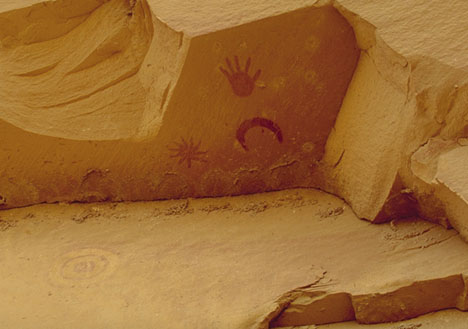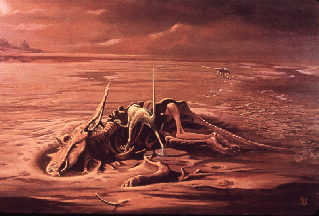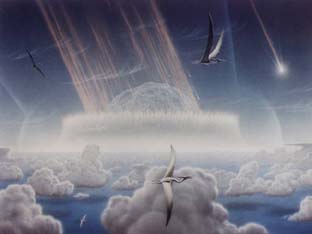
| 
|
History of Mans Observing the Sky 
photo by Ron Lussier The above picture is of 1054 Supernova, and Halley's Comet. This photo was taken in Chaco Canyon.
If you look through a telescope tonight, in the constellation Taurus, you will see a formation we call the "Crab Nebula." This cloudy, glowing mass comprises about 90% of the remains of a supernova that first appeared here around July 4, 1054.
A supernova is the explosion of a large star. Our sun is too small to create a supernova. The star that created the Crab Nebula was much bigger. When a supernova occurs, the majority of the matter in the star is blown out at nearly the speed of light. If you are close, you don't get to watch it very long before you are blown to bits. If you are far away, it will look like a very bright star, once the light from the explosion has taken its time to reach you.
The star that caused the 1054 supernova is about 6300 light years away, and much of the supernova's energy had diminished through space before it reached the earth. Nevertheless, on July 4, 1054, 6300 years after the Crab Nebula supernova actually occurred, a star six times brighter than Venus appeared in the sky. It was visible on Earth at high noon, and stayed visible for 23 days. The supernova was so strong that had it occurred within 50 light years of Earth, all living things on the planet might have been destroyed.
The Chinese and Japanese record the appearance of a very bright "guest star" around this time. And if you were a Chacoan living at the same time, you would notice it, probably even record it.
In fact, on the underside of a shelf below West Mesa in Chaco Canyon, just outside the great house called Peņasco Blanco, is a panel containing three symbols: a large star, a crescent moon, and a handprint.
Halley's comet made its appearance just a few years after the 1054 supernova. If you were a Chacoan living around this time, you would definitely notice Halley's comet: its appearance threw many civilized peoples into fear. And since observing the heavens was an important aspect of Chacoan culture, you would probably record it
http://www.chaco.com/park/
Crab Nebula Super Nova 
| 
| 
| 
| 
| 
|
Why Study Astronomy and Cosmology? 
Why should we worry about whats going on out in space? I mean it doesn't effect what I'm doing down here on Earth!... 
If you really think that what happens out in space doesn't effect your life... Lets just look back around 65 million years ago when the Dinosaurs once roamed Earth. About 65 million years ago there was an impact of a large object... meteor smashed into the Earth killing almost every living thing on the planets surface. It hit in the gulf of Mexico off the northwest tip of the Yucatan Peninsula making a huge crater... Scientists know this by studying a layer of iridium that covers the entire Earths surface.

This event changed the way life took its course. In fact if this meteor hadn't of hit Earth the dinosaurs would still be walking around eating up our ancestors the rodents.
Yes an event from space made it possible for you to even be here. So I'd say that events in space can play a very large part of what goes on down here on Earth and in our lives. Okay so maybe the discovery of gama-radiation from the early universe doesn't interest you. Maybe you could care less if we find out what the contents of Jupiters clouds are. And who cares if bacterial life is growing in the frozen rocks of Mars? Whats that got to do with me? Well nothing really. But if no one ever stopped to ask why things are the way they are then we'd probably still be picking flees out of each others fur coats!
From comets and asteroids to super novae and black holes there are many dangers lurking out there in the cold darkness of space. By knowing about the dangers we can survive them. Even the Sun our own star Sol could one day wipe us out in a solar burp where super charged solar particles will rip through the ozone layer of Earth and microwave us alive. Its up to us to understand and learn how we can stop these things from destroying us. Or else we'll have no one to blame but ourselves for our exinction.
We must understand our universe and learn to harness its powers to our advantage. We must learn to harness the power of the Sun. We should explore the other planets and their moons. There we will find more then knowledge but useful rescources and worlds for our taking. We are the gods of the night and our universe is our playground. Let us take it and do with it what we will for the only ones stoping us is us.

| 
| 
|

